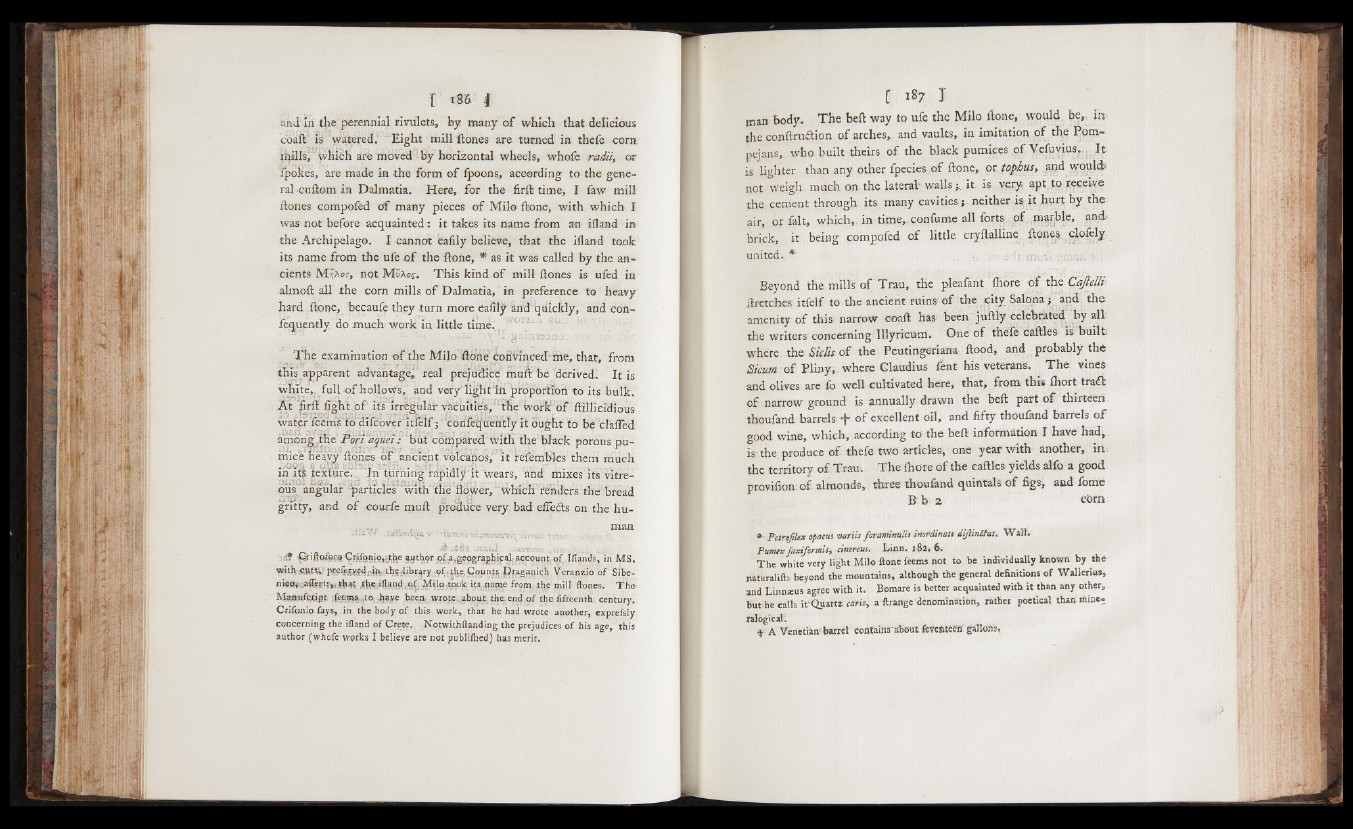
and in the perennial rivulets, by many o f which that delicious
coaft is watered. Eight mill ftones are turned in thefe corn
imlls;vwhiéh aré moved by horizontal wheels, whofe radii, or
fpokes, are made in the fOrm o f fpoons, according to the general
-cnftom in Dalmatia. Here, for the firft time, I faw mill
ftones compofed Of many pieces o f Mil® ftone, with which I
was not before acquainted: it takes its name from an ifland in
the Archipelago. I cannot eafily believe, that the ifland took
its name from the ufe o f the {tone, * as it was called by the ancients
M?aor, not MuAoj. This kind o f mill {tones is ufed in
aim oft all the corn mills o f Dalmatia, in preference to heavy
hard ftone, becaufe they turn more eafily and quickly, and con-
fequently do much work in little time; 5
Í | H / ‘X"'1 S i
The examination o f the Milo ñ o tfé cottidncedme, that, from
this apparent advantage^ real prejudice mufthe derived. It is
white,, full o f hollows,' and very lighten proportion to its bulk.
A t jirft figh t p f its irréguláf yaeüitÍéV,’:ffie work' o f ftilliridious
water feems to difcoveritfelf; 'confequently it Ought to be clafled
¿mbngthe P ó fi dquM : butréompared With the black porous pu-
rnicfe heavy ftones o'f ancient volcadnos,7 it refenibks them much
in 16 textureft.''*In tumirig rapidly it wears, and mixes its vitreous
angular ^particles “with'ftfie flower, which renders the bread
gritty, and o f courfe mult produce very bad eifefts on the hu-
H VT a f • maIi
. . .d ,s8 i mr.id iU ir iife .i
* gjriftoibrQ CriíOHÍOjilhc author utha,geographical, account of Iilands, in MS.
w-ithcutW :tfteTl.ibrary :o fv ,Coun t^ .p^aganich YeranziO of Sibentofli
,aCej-tfvl jbat. ,th,e i fl and,of Milo,took its. name from: the milt ftones. The
Man.ufcc.ipt jM B j f y W heengwrote .about th&end of the fifteenth century,
Crifonio fays, in the hotly o f this work, that he had wrote another, exprefsly
concerning the ifland of Crete. Notwithftanding the prejudices of his age, this
author (whofe works I believe are not publifhed) has merit.
man body. The beft way to ufe the Milo ftone, would be, p
the conftruftion o f arches, and vaults, in imitation o f the Eom-
pejans, who built theirs o f the black pumices o f Veiuvius,.. I t
is lighter than any other fpecies o f ftone, or tophus, and vyqujdi
not weigh much on the lateral' walls ; it. is very apt to receive
the cement through its many cavities j neither is it hurt by the
air, or fait, which, in time,.confume all forts of marble, and
brick, it being compofed o f little cryftalline. fton^^cjofely.
united.. §f
Beyond the mill's o f Trau, the pleafant lliore o f the Cajlelli
ftretches itfelf to the ancient ruins o f the city Salqna ; and the
amenity of this narrow coaft has; been juftly celebrated by all
the writers concerning lllyricuni. One o f thèfe caftles is built
where the Siclis of the Peutingeriana- ftood, and probably thé
Sicum o f Pliny, where Claudius fent his veterans. T h e vines
and olives are ib well cultivated Here, that, from this ihort tratft
o f narrow ground is annually drawn the beft part o f thirteen,
thoufand barrels f o f excellent oil, and fifty thoufand barrels o f
good wine, which, according to the beft information I have had,
is the produce of thefe two articles, one year with another, in
the territory of. Tram The ihore o f the caftles yields alfo a good
provilion o f almonds, three thouiànd quintals o f figsj and fome
R b 2 cbtn
*• Petnftlex opacus variis faraminulil ¡Mrdinau difiinitus. W a ll.
Pum/X faxiformis, cintrtus, I#inn. IH2, 6.
T h e white very light Milo ftone feems not to be individually known by the
naturaliib beyond the mountains, although the general definitions of Wallerius,
and Linnæus agree with it. Bomare is better acquainted with it than any other,
But he calls it'Quartz cirii, a ftrange denomination, rather poetical than mine;
ralogical.
|f! A Venetian'barrel contairtS'abCut feventéen gallons.